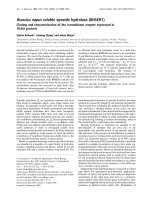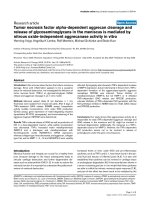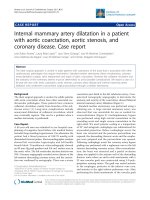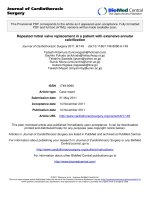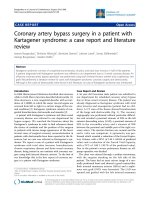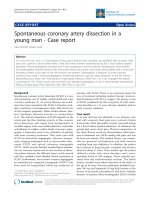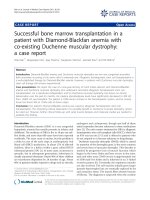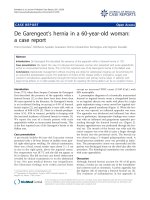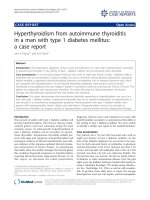Báo cáo y học: " Fluorodeoxyglucose-positron emission tomography/computed tomography in the staging and evaluation of treatment response in a patient with Castleman''''s disease: a case report" pps
Bạn đang xem bản rút gọn của tài liệu. Xem và tải ngay bản đầy đủ của tài liệu tại đây (454.49 KB, 4 trang )
BioMed Central
Page 1 of 4
(page number not for citation purposes)
Journal of Medical Case Reports
Open Access
Case report
Fluorodeoxyglucose-positron emission tomography/computed
tomography in the staging and evaluation of treatment response in
a patient with Castleman's disease: a case report
Ettore Pelosi*
1
, Andrea Skanjeti
†2
, Angelina Cistaro
†1
and Vincenzo Arena
†1
Address:
1
IRMET PET Center, Via Onorato Vigliani, 10138 Turin, Italy and
2
Nuclear Medicine Unit, University of Turin, Corso Bramante, 10126
Turin, Italy
Email: Ettore Pelosi* - ; Andrea Skanjeti - ; Angelina Cistaro - ;
Vincenzo Arena -
* Corresponding author †Equal contributors
Abstract
Introduction: Castleman's disease is a rare lymphatic polyclonal disorder that is characterised by
unicentric or multicentric lymph node hyperplasia and non-specific symptoms and signs including
fever, asthenia, weight loss, enlarged liver and abnormally high blood levels of antibodies.
Case presentation: We present the case of a 74-year-old man with Castleman's disease. The
disease was detected with a contrast-enhanced computed tomography (CT) scan and a
fluorodeoxyglucose (FDG)-positron emission tomography (PET)/CT study; diagnosis was made
with histopathology. After treatment with surgical excision followed by chemotherapy, the disease
response was evaluated using both diagnostic techniques. However, only the PET study was able
to identify the spread of the disease to the abdominal lymph nodes, which were both enlarged and
normal size, and, after treatment, to evaluate the disease response.
Conclusion: Based on the results of previous case reports and on those of the present study, it
seems that Castleman's disease has a high glucose metabolic activity. Therefore, the use of PET can
be considered appropriate in order to stage or restage the disease and to evaluate the response of
the disease to treatment.
Introduction
Castleman's disease is a rare lymphatic polyclonal disor-
der that is characterised by unicentric or multicentric
lymph node hyperplasia and non-specific symptoms and
signs including fever, asthenia, weight loss, enlarged liver
and abnormally high blood levels of antibodies. In 1954,
Castleman and Towne [1] described the first case of the
disease in a patient with a mediastinal mass. Then, other
authors reported new cases of the disease with different
localisations, including abdominal and superficial lymph
nodes. The aetiology and pathogenesis are still unclear
and under debate. Diagnosis and classification are based
on histopathological analysis. Surgical excision is the rec-
ommended treatment in the unicentric form, while differ-
ent systemic therapeutic strategies can be adopted for the
multicentric form [2].
Case presentation
A 74-year-old man was referred to our centre in July 2006,
for a mesenterial lymphatic mass to be characterised met-
Published: 3 April 2008
Journal of Medical Case Reports 2008, 2:99 doi:10.1186/1752-1947-2-99
Received: 11 July 2007
Accepted: 3 April 2008
This article is available from: />© 2008 Pelosi et al; licensee BioMed Central Ltd.
This is an Open Access article distributed under the terms of the Creative Commons Attribution License ( />),
which permits unrestricted use, distribution, and reproduction in any medium, provided the original work is properly cited.
Journal of Medical Case Reports 2008, 2:99 />Page 2 of 4
(page number not for citation purposes)
abolically with 18F fluorodeoxyglucose (FDG)-positron
emission tomography (PET). The patient was treated pre-
viously for prostatic adenocarcinoma with radiotherapy
and anti-androgen treatment with bicalutamide. During
the follow-up, an anomalous lymph node (size 32 mm ×
50 mm) at the mesenterial level was identified using both
ultrasonographic examination and a contrast-enhanced
computed tomography (CT) scan.
The PET scan was acquired 60 minutes after intravenous
injection of FDG (248 MBq). At the time of the tracer
injection, the patient had fasted for more than six hours,
and the glucose blood level was 81 mg/dl. The PET study
showed the presence of anomalous tracer uptake in the
mesenterial mass (maximum standardised uptake value
[SUVmax] 6.03; Figure 1). Further pathological tracer
uptakes were depicted in the lymph nodes (not exceeding
15 mm in size) in the mesenteric and iliac bilateral
regions (Figure 2).
Based on this result, the patient underwent excision of the
mesenterial lymphatic mass and histopathological analy-
sis showed Castleman's disease of the hyalin-vascular sub-
type. From October 2006 to February 2007, the patient
was treated with four cycles of chemotherapy. A further CT
scan of the abdomen was performed at the end of the
treatment and then again in June 2007; a second PET/CT
study with FDG was performed in June 2007. The CT scan
showed the persistence of the mesenteric and iliac lymph
nodes which remained stable in size. However, FDG-PET
scan did not reveal any pathological uptake in those
lymph nodes suggesting a complete disease response to
the treatment (Figure 3).
No clinical signs suggestive of recurrence were seen during
a follow-up at five months.
Discussion
FDG-PET/CT is a hybrid diagnostic technique used in
many neoplasms and aggressive malignant lymphomas to
characterise metabolically undetermined masses, tumour
staging and restaging, treatment response evaluation and
radiotherapy treatment planning. In fact, it allows a com-
bination of both anatomical and biological co-registered
images acquired in the same session, with a dual gain in
diagnostic accuracy.
Staging is crucial in the identification of the appropriate
treatment in Castleman's disease. CT or magnetic reso-
nance imaging (MRI) is commonly used. The usefulness
of FDG-PET/CT has been reported in a few cases [3-7].
However, based on the results of these reports and on
those of the present study, PET seems to represent the
most appropriate approach. In fact, Castleman's disease,
as with aggressive lymphomas and many solid tumours,
presents an increase in glucose metabolic activity. There-
fore, PET study can lead to a more precise staging of the
disorder since the disease can be present in normal-sized
lymph nodes as in our case and, alternatively, reactive
lymph nodes with increased size can be erroneously
judged as pathological. Furthermore, a PET study can be
used to evaluate disease response to treatment as in our
case: although the lymph nodes were still present after
treatment, their metabolic activity had significantly
decreased suggesting, together with clinical signs, a com-
plete disease response.
Conclusion
This case report shows that FDG-PET/CT could have an
important role in the staging of Castleman's disease and
in its evaluation of treatment response.
FDG-PET/CT transaxial views of the mesenterial lesionFigure 1
FDG-PET/CT transaxial views of the mesenterial lesion. (A) PET; (B) low-dose CT; (C) PET/CT fusion.
Journal of Medical Case Reports 2008, 2:99 />Page 3 of 4
(page number not for citation purposes)
Competing interests
The author(s) declare that they have no competing inter-
ests.
Authors' contributions
EP is the senior author and was involved in collecting
patient details, reviewing the literature and final proof-
reading of the manuscript. AS was involved in collecting
FDG-PET/CT transaxial views of the left iliac lymph nodeFigure 3
FDG-PET/CT transaxial views of the left iliac lymph node. (A) Low-dose CT; (B) PET. Upper images: pre-treatment
(SUVmax 2.4); lower images: post-treatment (SUVmax 1.8).
FDG-PET/CT transaxial views (PET/CT fusion)Figure 2
FDG-PET/CT transaxial views (PET/CT fusion). (a), (b) Iliac bilateral and (c) mesenteric pathologic lymph nodes.
Publish with BioMed Central and every
scientist can read your work free of charge
"BioMed Central will be the most significant development for
disseminating the results of biomedical research in our lifetime."
Sir Paul Nurse, Cancer Research UK
Your research papers will be:
available free of charge to the entire biomedical community
peer reviewed and published immediately upon acceptance
cited in PubMed and archived on PubMed Central
yours — you keep the copyright
Submit your manuscript here:
/>BioMedcentral
Journal of Medical Case Reports 2008, 2:99 />Page 4 of 4
(page number not for citation purposes)
patient details, reviewing the literature and drafting the
manuscript. AC was involved in reviewing the literature
and proofreading the manuscript. VA approved the final
manuscript.
Consent
Written informed consent was obtained from the patient
for publication of this case report and accompanying
images. A copy of the written consent is available for
review by the Editor-in-Chief of this journal.
References
1. Castleman B, Towne VW: Case records of the Massachusetts
General Hospital: case 40011. N Engl J Med 1954, 250:26-30.
2. Dham A, Peterson BA: Castleman disease. Curr Opin Hematol
2007, 14:354-359.
3. Murphy SP, Nathan MA, Karwal MW: FDG-PET appearance of
pelvic Castleman's disease. J Nucl Med 1997, 38:1211-1212.
4. Kunishima S, Taniguchi H, Koh T, Yamaguchi A, Yamagishi H: F-18
fluorodeoxyglucose positron emission tomography in
mesenterial Castleman's lymphoma. Clin Nucl Med 2001,
26:789-790.
5. Blockmans D, Maes A, Stroobants S, Bobbaers H, Mortelmans L:
FDG positron emission tomographic scintigraphy can reveal
Castleman's disease as a cause of inflammation. Clin Nucl Med
2001, 26:975-976.
6. Reddy MP, Graham MM: FDG positron emission tomographic
imaging of thoracic Castleman's disease. Clin Nucl Med 2003,
28:325-326.
7. Enomoto K, Nakamichi I, Hamada K, Inoue A, Higuchi I, Sekimoto M,
Mizuki M, Hoshida Y, Kubo T, Aozasa K, Hatazawa J: Unicentric and
multicentric Castleman's disease. Br J Radiol 2007,
80(949):24-26.
